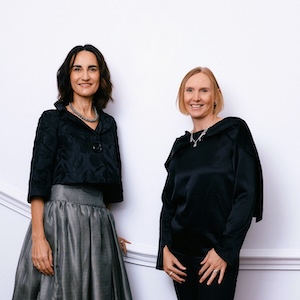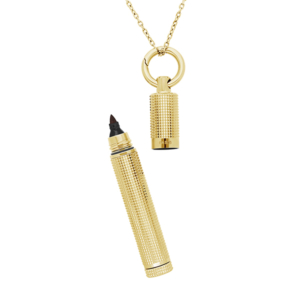
JCK editor-in-chief Victoria Gomelsky and news director Rob Bates sit down with Mahiar Borhanjoo, CEO of UNI.DIAMONDS, and Feriel Zerouki, senior vice president of corporate affairs at De Beers Group and incoming CEO of the World Diamond Council, to find out how the couple fell in love with the diamond industry—and with each other. This knowledgeable husband-and-wife team also update listeners on De Beers’ newest initiatives to improve traceability and support artisanal miners, and they offer insights into upcoming G7 requirements likely to affect the entire diamond industry.
Listen Now
Sponsored by De Beers: institute.debeers.com
Show Notes
2:40 Perfect pair
8:34 A memorable meeting
13:40 Diamond prices stabilize
14:43 New G7 requirements on diamond imports
19:27 With Tracr, provenance takes center stage
21:33 GemFair’s win-win approach
Episode Credits
Hosts: Rob Bates and Victoria Gomelsky
Producer and engineer: Natalie Chomet
Plugs: @jckmagazine; institute.debeers.com
Show Recap
Perfect pair
Victoria introduces her London-based guests and asks how the world of diamonds brought them together. Mahiar was born in Iran, grew up in Salt Lake City, and went to college in California—continents away from Feriel, born to Algerian parents in Abu Dhabi and raised in the U.K. Though he started his career in tech and financial services, Mahiar was offered a job in the diamond industry in London—and jumped at it. The move exposed him to the best kind of culture shock: “I was used to contracts and letters of intent,” he recalls. In diamonds, “the word mazal was your bond.” The trust and passion people showed felt like a breath of fresh air, says Mahiar, who worked with De Beers and Venus Jewel before joining UNI.DIAMONDS, which provides real-time data-driven insights on market prices, supply, demand, and availability to diamond retailers and wholesalers.
After earning her degree in mathematics and business management, Feriel also found her way to the diamond industry—as a supply chain analyst for De Beers. Her job was to use blue sky thinking to improve diamond forecasting accuracy. She too experienced culture shock, but of a different kind: Almost 20 years ago, she was the only woman and the youngest person in the room. “I stood out like a sore thumb,” she says. Happily, the industry has made great strides to improve diversity, she says.
A memorable meeting
When Feriel and Mahiar first met during a 2008 business trip to India, they were on opposite sides of the table. It was “sales versus ethics,” as she puts it: Mahiar was managing rough diamond sales globally, Feriel was managing De Beers’ best practice principles.
“She came so well prepared…for any question that I would have, and I was completely taken away not just by her beauty and her charm but very much so by her intellect,” Mahiar recalls. He insisted the group have dinner together, then visit the top of the InterContinental hotel, famous for its breathtaking views. Feriel and Mahiar talked for hours—until she left for the airport the next morning. On the plane home, she told her co-workers she’d met the man she was going to marry.
Tragically, terrorists struck Mumbai that day, and the budding romance was put on pause. “We worked very hard to get the sales team out,” Feriel remembers. “When [Mahiar] finally got out, I was so eager to see him that I actually asked him out. And he said…no.”
For Mahiar, the attack triggered painful memories of the Iranian revolution. “I needed to work through some of the stuff I had boxed up neatly in my brain,” he explains. After clearing his head, he “profusely apologized and asked her out. Now we’re 13 years married, we have a beautiful baby girl, and we’re working hard to change the industry,” he reports.
Diamond prices stabilize
Speaking of changes, Rob asks the couple’s views on the current state of the industry. Prices spiked at the end of the first quarter but have decelerated, now hovering slightly above 2021 levels, says Mahiar. “We’re seeing much more price stability in the market, which means supply-and-demand aspects are starting to fall in line,” he says. “I’m quite pleased with where we are.”
New G7 requirements on diamond imports
In addition to existing sanctions on diamonds from Russia, the G7 countries will soon impose new regulations on all natural diamonds coming into member countries, Feriel notes. “They’re going to be at customs, so they’re going to impact everybody.” And in an industry that has always sorted diamonds based on the 4Cs, the idea of provenance is still new, particularly to the informal sector, creating a learning curve, she says.
While details aren’t yet known, the new requirements must support the G7’s objectives without negatively impacting the legitimate natural diamond trade, says Feriel. She praises U.S. ambassador James O’Brien and his team for their recent fact-finding mission to better understand the supply chain and work toward a solution that won’t leave anyone behind.
With Tracr, provenance takes center stage
Rob invites Feriel to elaborate on Tracr, De Beers’ traceability solution, launched in 2018, which GIA recently joined. “We always knew provenance was going to be very important for natural diamonds and, frankly, for any product that’s going to be sold into the consumer market,” she says. Consumers want products that reflect their values, but how can you know what your product stands for without knowing where it originated?
Enter Tracr, which provides provenance information, ensuring that a diamond’s origin story can be accurately represented when it’s sold to a consumer. “When we came up with it, most people were saying, ‘Why do you need this? No consumer is asking,’” says Feriel. “They’re not asking now, but they’re going to be asking in the future. We truly believe that.”
GemFair’s win-win approach
Feriel is perhaps even prouder of GemFair, De Beers’ program with artisanal miners to raise the standards of mine sites and develop a fair route to market for their product.
“Being able to see diamonds on a platform like ours from Sierra Leone, and being able to talk about what positive impact diamonds have in various countries that they’re in, has been a great story to [share with] consumers,” Mahiar says. It provides an “opportunity to fully appreciate how wonderful natural diamonds are in the countries they come from.”
Miners can sell to De Beers once they meet GemFair standards—guidelines De Beers worked with miners to develop. The De Beers team uses these interactions as educational opportunities, helping miners understand the value of their product, even if they choose to sell elsewhere.
During the pandemic, the company shifted its business in Sierra Leone to support the mining community in the face of massive inflation, ensuring that people had access to food and health care. “We found a solution with them where we would rehabilitate old mines and transform them into farming grounds. We have rehabilitated 126 mines since COVID. The women of the community manage the farming, [and] the overflow product is what they use to sell into the market,” Feriel explains. “It’s created new livelihood solutions for the mining communities and helped us build trust. Now that the communities know we’re here to stay, the volume of diamonds coming our way because of that trust has increased.”
While you won’t find GemFair diamonds at JCK Las Vegas, “if you want to try on a diamond from Sierra Leone or anywhere else—Botswana, Namibia, Canada, South Africa—come to my booth and you can virtually try it on,” Mahiar says.
(Photo courtesy of Feriel Zerouki and Mahiar Borhanjoo)
- Subscribe to the JCK News Daily
- Subscribe to the JCK Special Report
- Follow JCK on Instagram: @jckmagazine
- Follow JCK on X: @jckmagazine
- Follow JCK on Facebook: @jckmagazine







